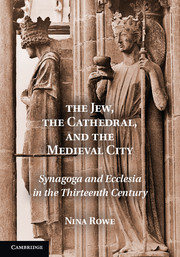Book contents
- Frontmatter
- Contents
- List of Illustrations
- Acknowledgments
- Abbreviations
- Introduction: The Jew, the Cathedral, and the Medieval City
- PART I IMAGINING JEWS AND JUDAISM IN LIFE AND ART
- 1 The Jew in a Christian World: Denunciation and Restraint in the Age of Cathedrals
- 2 Ecclesia and Synagoga: The Life of a Motif
- PART II ART AND LIFE ON THE ECCLESIASTICAL STAGE – THREE CASE STUDIES
- Notes
- Glossary
- Bibliography
- Index
2 - Ecclesia and Synagoga: The Life of a Motif
Published online by Cambridge University Press: 05 January 2012
- Frontmatter
- Contents
- List of Illustrations
- Acknowledgments
- Abbreviations
- Introduction: The Jew, the Cathedral, and the Medieval City
- PART I IMAGINING JEWS AND JUDAISM IN LIFE AND ART
- 1 The Jew in a Christian World: Denunciation and Restraint in the Age of Cathedrals
- 2 Ecclesia and Synagoga: The Life of a Motif
- PART II ART AND LIFE ON THE ECCLESIASTICAL STAGE – THREE CASE STUDIES
- Notes
- Glossary
- Bibliography
- Index
Summary
From antiquity through the High Middle Ages, theologians and rulers sought to explicate, control, and qualify Christianity's relation both to the history of Judaism and to contemporary Jews. In this same era, artists formulated and refined a visual motif that insisted on the coherence of the split heritage of the church – the paired figures of Ecclesia and Synagoga. These twinned feminine personae emerged from a classic repertory of themes, achieved popularity in court circles of the Carolingian age, and were embraced in ecclesiastical intellectual milieux in the subsequent centuries. It was only in the thirteenth century, however, that sculptors adapted the Ecclesia-Synagoga motif to the setting of the cathedral façade, articulating the theme in monumental, three-dimensional form. That, however, is the story told in the second half of this book. Before we can examine the revolutionary work effected by the figures of Ecclesia and Synagoga at the cathedrals of Reims, Bamberg, and Strasbourg, it is necessary to analyze the sources and development of the visual motif itself, locating its origins in an antique imperial vocabulary of power and discerning its transformation with the migration of Jews to northern Europe in the eleventh and twelfth centuries.
FEMALE PERSONIFICATIONS IN THE ANCIENT WORLD
The use of female personifications to convey the idea of the supersession of Christianity over the Jewish tradition has dual roots in scripture on the one hand and antique pictorial conventions on the other.
- Type
- Chapter
- Information
- The Jew, the Cathedral and the Medieval CitySynagoga and Ecclesia in the Thirteenth Century, pp. 40 - 78Publisher: Cambridge University PressPrint publication year: 2011



